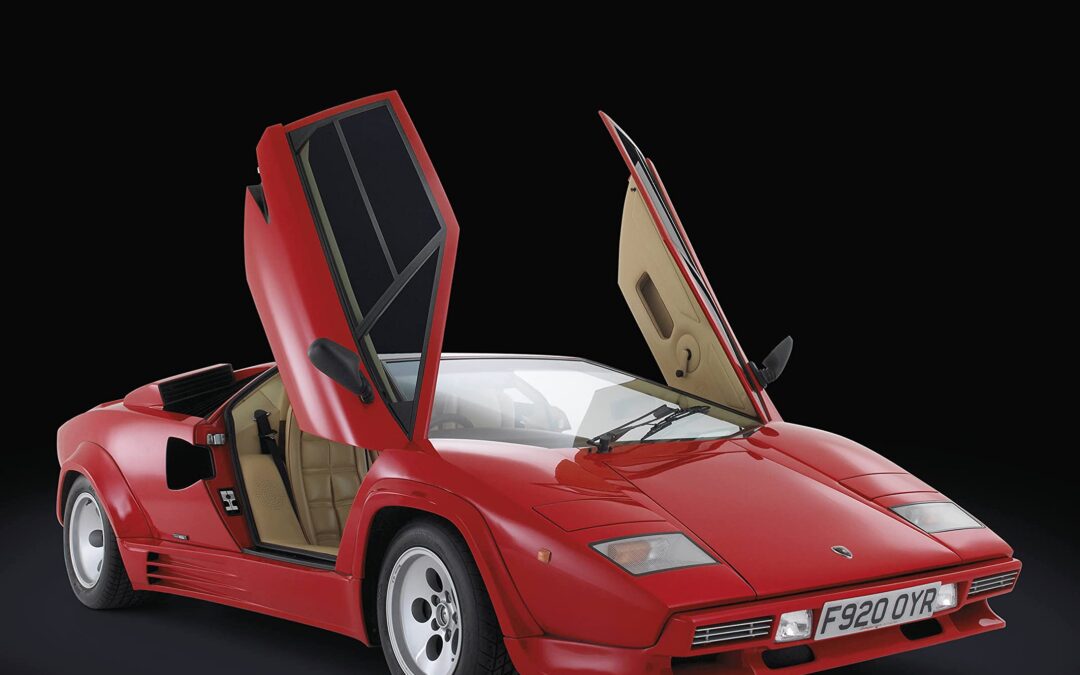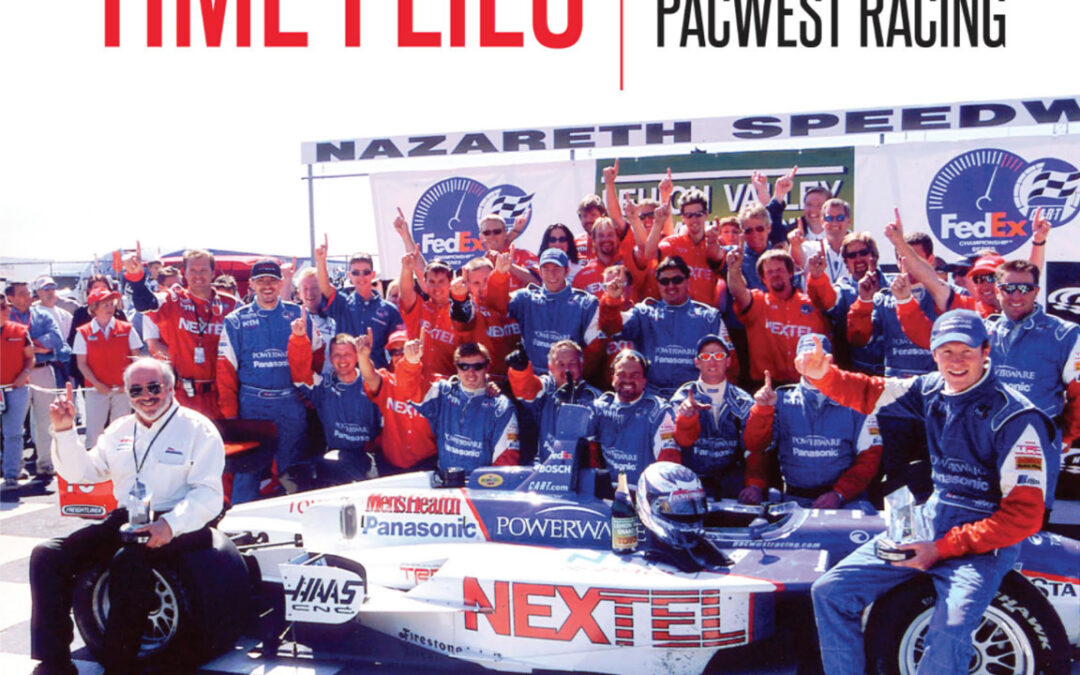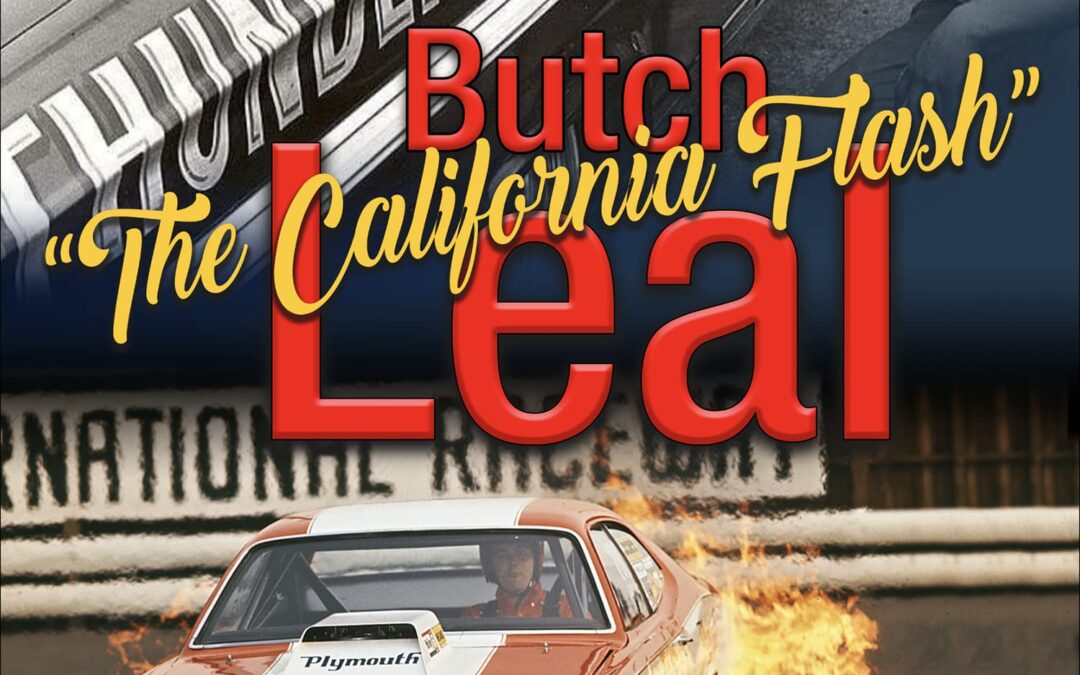
Check out the first ever biography on the popular drag racer, Butch “The California Flash” Leal.
Born and raised in central California, Larry “Butch” Leal was obsessed with cars from a very early age. What began with field cars turned into hard work and new Chevrolets. This took place when the golden era of drag racing was in its infancy, and Leal joined with enthusiasm. He performed well at the track with his early Chevys and had an impressive number of wins before he was out of high school. His success brought him plenty of attention and collaboration with other big names in the sport.
In 1963, GM pulled out of the sport on an official basis. As a result, Butch (at age 19) teamed up with Mickey Thompson and joined the Ford camp, securing a ride with the factory team and its new Thunderbolts for 1964. After his success that season, including winning the Super Stock (S/S) class at the 1964 NHRA US Nationals in Indianapolis, Chrysler came calling, and Butch signed on to race the new altered-wheelbase cars in match races for 1965, as the NHRA did not have a class for these new “funny” looking cars. While Leal dabbled again with Ford and Chevrolet later, his relationship with Chrysler lasted well into the following decades, running both Funny Cars and Super Stockers.
Penned by talented automotive historian Bob McClurg, who was there for it all, and featuring full collaboration with the book’s subject, Butch “The California Flash” Leal covers the span of his fascinating career during arguably the most interesting era in drag racing history. Butch was an 11-time NHRA champion and 4-time recipient of Car Craft magazine’s All-Star Driver of the Year award in a career that spanned the 1960s through the 1990s. It’s all here, the events, great vintage photography, and the stories from one of the best storytellers the NHRA has ever known. Add this entertaining volume to your drag racing library today.

Researched and written in Japan with the full co-operation of the factory, The Book of the Mazda MX-5 Miata is the story of the third generation of Mazda’s MX-5 – a car that re-invented the affordable lightweight convertible, a breed that many thought was extinct as the 1990s drew near.
Successful immediately, the MX-5 (also known as the Miata, or Roadster) spawned many imitators, but remains the world’s best selling sports car of all time. The series has now been in production for more than 30 years, with new generations following the concept of the original, much to the delight of fans around the globe.
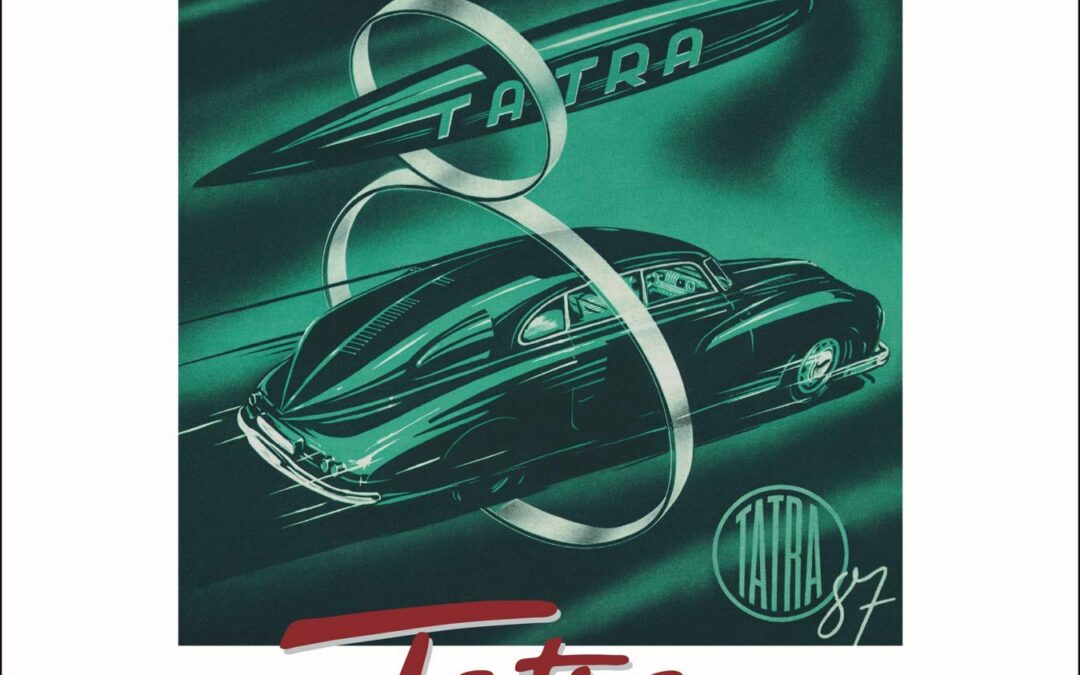
Tatra – The Legacy of Hans Ledwinka is the story of the Tatra company, which originated in the Central European country of Czechoslovakia. It is a tale of great innovation and avant-garde design in automobile engineering. It is also the story of one man – Hans Ledwinka – and his visionary concepts which have become highly influential, although often undervalued, contributions to the development of car technology.
Until now, Hans Ledwinka’s talent has hardly been recognised; in retrospect, he can be judged equal to car designers such as Benz, Daimler and Porsche, whose endeavours have been fully recorded many times over. With his revolutionary Tatra cars, Ledwinka consistently pushed back the frontiers of automobile construction, and it’s certain that without his inspiration, the Volkswagen in its air-cooled rear-engined form would perhaps never have been conceived. This book suggests that Ledwinka played a greater part in this development than has previously been appreciated.
The authors have covered the full history of the Tatra company, which is one of the oldest factories in continuous automobile manufacture, dating back to the 19th century. By doing this, they have placed both Ledwinka and the Czechoslovak Tatra company in their rightful place in the history of car design, and provided a fully comprehensive assessment of the influence of Tatra car designs and their inspired creator.
The text of this larger format 2nd edition has been fully revised and updated since the 1990 edition. This new edition also contains many additional illustrations. The book also has a new foreword, written by Norman Foster, the British architect, and proud owner of a Tatra T87, who pays tribute to the aesthetic qualities of this design classic and captures the fascination of both designers and motor historians with the development of Tatra.

Researched and written in Japan, with the full co-operation of the factory, here, in definitive detail, is the complete story of the first generation of Mazda’s MX-5 – the car that re-invented the affordable lightweight roadster, a species that many thought was extinct as the 1990s drew near.
Immediately successful, the MX-5, also known as the Miata or Eunos Roadster, spawned many imitators, but remains the world’s biggest selling sports car. The series has now been in production for well over 20 years, and new generations continue to follow the concept of the original, much to the delight of fans and enthusiasts all over the world.
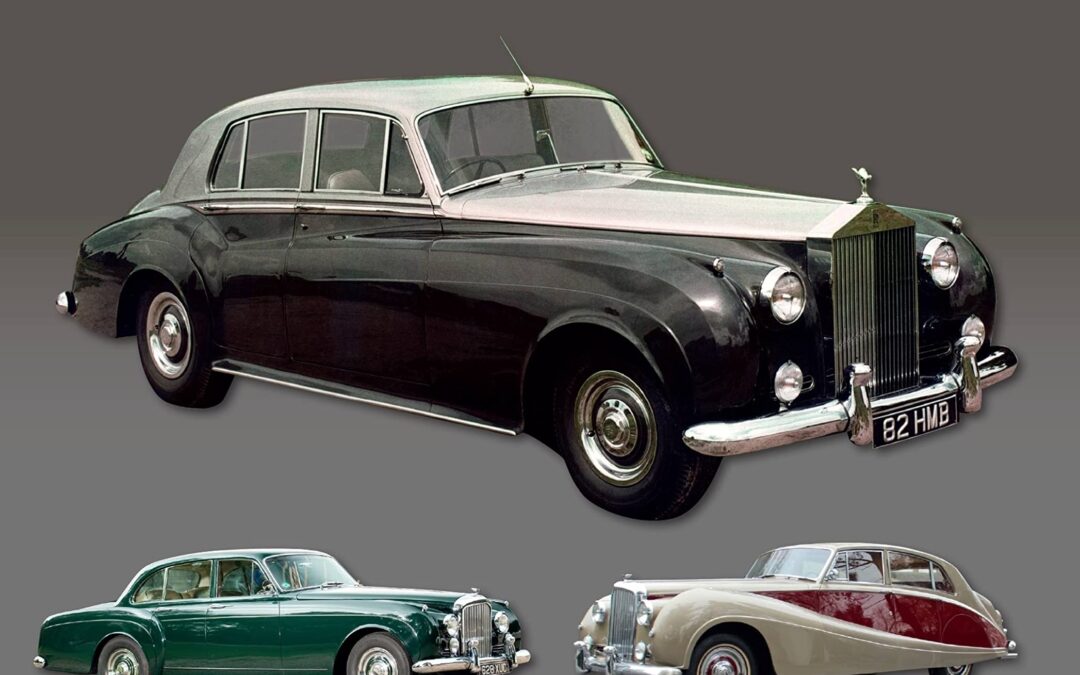
The Rolls-Royce company acquired Bentley Motors in 1931 and, although models continued to be produced with the Bentley name, they increasingly used many Rolls-Royce components. By the time the Silver Cloud and Bentley S were released in 1955, they were really differently badged versions of the same design. Yet the sporting tradition of the Bentley marque was upheld with the exotic Continental models that were derived from them.
The Silver Cloud family represents a pinnacle for the Rolls-Royce company. The cars all had and still have a very special presence, and the standard saloons have an unsurpassed elegance and rightness of line. The special-bodied cars, meanwhile, are reminders of an age when the skill of the best coachbuilders was something deserving of universal admiration.
With around 190 photographs, this book features:
- The story of the design and development of the Rolls-Royce Silver Cloud and Bentley S Type
- A look at the production development of these cars between 1955 and 1965
- An examination of the Bentley Continental models that were derived from Silver Cloud and S Type design
- The history of the Phantom V and Phantom VI limousine chassis introduced in 1959 and destined to last until 1990
- Full technical specifications, including paint and interior trim choices
- Production figures and chassis codes
- A chapter on buying and owning one of these wonderful classic cars.
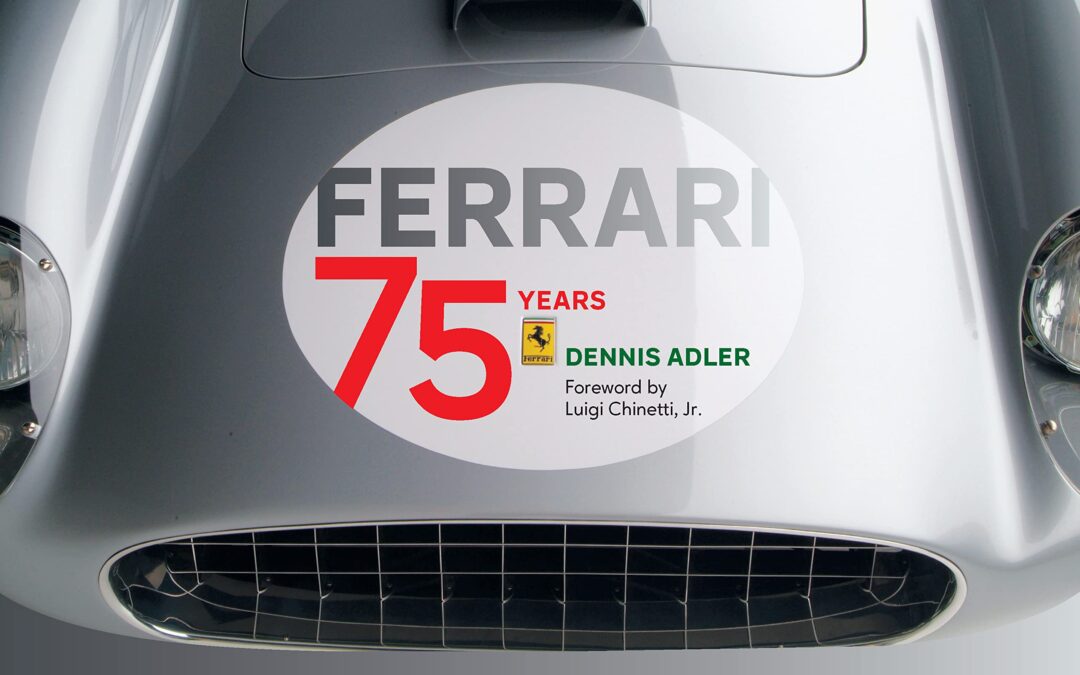
Celebrate 75 years of Ferrari with this complete, fascinating, and stunningly illustrated history highlighting the company’s legendary sports cars and their worldwide influence.
A stellar combination of beauty, engineering, racing success, exclusivity, and Italian flair combine to make Ferrari the world’s most legendary carmaker. All these traits coalesce in the form of Ferrari’s road cars. No other sports car manufacturer has so consistently set the bar for style and performance. It’s a near unbroken 75-year run of automotive hits:
- The 125S in 1947
- The versatile 340 in the 1950s
- The stunning 250s and 275s of the 1960s
- The Daytona in the 1970s
- The shocking F40 in the 1990s
- The modern era’s outrageous hypercars like the Enzo, F8, and LaFerrari
Ferrari: 75 Years dives deep into Ferrari’s sports car history beginning in 1947, but also examines Enzo Ferrari’s early career with Alfa-Romeo before he launched his legendary company.
Automotive historian and photographer Dennis Adler offers Ferrari owners and fans a full and fascinating picture of Maranello’s 75 years of sports car manufacturing. Adler’s detailed text is accompanied by his breathtaking photography and supplemented by important historic images.
For 75 years, Ferrari has created high-performance automotive works of art to fire the imaginations of car lovers and performance enthusiasts the world over. Ferrari: 75 Years provides an inspiring and illuminating look back at this history.
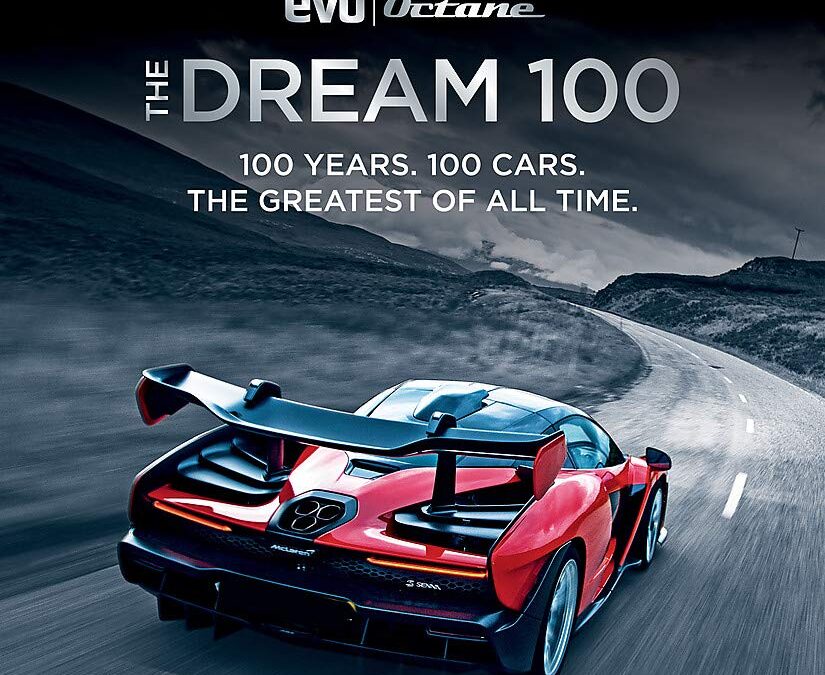
The 100 greatest cars of all time, as chosen by the experts at Evo and Octane magazines.
100 cars across 100 years – the best of the best.
Explore the 100 greatest cars of all time, with every single one tried, tested, argued over and chosen by the respected experts at Evo and Octane magazines.
Covering an entire century, from legendary classics to the latest supercars, cult heroes to landmark designs, the 100 cars in this book represent the absolute pinnacle of driving history.
Including profiles on iconic car models such as the:
Bugatti Veyron (2005)
Lamborghini Diablo (1990)
Porsche Carrera 2.7 RS (1972)
…and many more.
With stunning imagery from the world-renowned Evo and Octane photographers alongside key performance figures and first-hand reports from behind the wheel, The Dream 100 is the final word in automotive excellence.
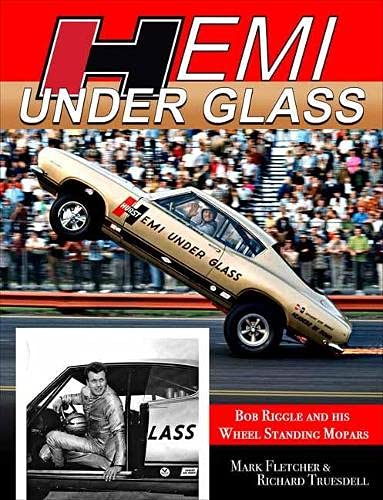
Look up to the skies through Bob Riggle’s eyes in this wheelstanding, must-have Mopar history book on Hemi Under Glass!
While the established stock and modified brackets are long-recognized as the heart and soul of drag racing, it was the wheelstanders that more often than not put butts in the bleachers. In that category, some of the most well-known names included Bill “Maverick” Golden’s Little Red Wagon, Bill Shewsberry’s L.A. Dart and Chuck Poole’s Chuck Wagon. Although, most memorable of all was the Hurst Hemi Under Glass Plymouth Barracuda campaigned by Bob Riggle.
Riggle started his career in the early 1960s as a car builder and mechanic for Hurst-Campbell and eventually ascended to pilot the Hemi Under Glass. When he left Hurst in 1969, the Hemi Under Glass franchise transferred with Riggle. He continued for six more years as the owner/driver of a succession of Hemi Under Glass renditions. In the 1990s he resurrected the concept of the original car—making four different versions (1966, 1967, 1968, and 1969)—and continued to thrill drag racing fans with his wheelstanding antics.
At the time of this writing, Bob’s last run with the Hemi Under Glass was in the summer of 2019. He claims to have retired (he was 83 years old at the time), but he’s claimed that before!
For all the success he enjoyed over his long and distinguished career, which is believed to be one of the longest in all of motorsports, he’s best remembered for a run at Irwindale Raceway in early 2016 with comedian and car buff Jay Leno in the passenger seat in a video that has been viewed more than 10 million times.
This is Bob’s story, one that Mark Fletcher and Richard Truesdell, co-authors of the 2012 book Hurst Equipped, are honored to share. They say the story was easy to tell—given their unprecedented access not only to Bob but also to his vast archive of photos that reflect his ongoing popularity. Many of the photos in this book are seen in print for the very first time.

As early as 1965, when the MiG-25 interceptor was in the midst of its test program, the Mikoyan Design Bureau started work on an even more capable two-seat interceptor meant to provide adequate protection for the huge expanses of Siberia and the Soviet Far East. Though superficially resembling a MiG-25 with tandem cockpits, the aircraft was soon designated the MiG-31.
Initially dubbed Super Foxbat in the West but soon renamed Foxhound, the MiG-31 first flew on 16 September 1975 and, after a five-year trials program, achieved initial operational capability in 1980. Full-scale deliveries began in 1982 to units covering the Moscow Air Defense Zone, the Arctic and the Far East. One of the effects was that the SR-71s now stayed away from the Soviet borders.
Efforts to improve the Foxhound began right away. In-flight refueling capability was added in 1989 to overcome the problem of inadequate range. Next, the MiG-31B, featuring upgraded avionics and better weapons, entered production in 1990; existing MiG-31s were brought up to the new standard (except for IFR capability) as the MiG-31BS.
The radically improved ‘Generation 4+’ MiG-31M featuring a new WCS and new R-37 ultra-long-range AAMs first flew in 1985 but never entered production because of funding shortages. Today, the MiG-31s remains one of modern Russia’s key air defense assets, and new versions keep appearing. The book gives the complete development and service history of this remarkable aircraft and is richly illustrated with color photos and color artwork throughout.

The Land Rover Story is a roller coaster ride through the life and times of Land Rover. Fast-paced and entertaining, it brings alive all aspects of Land Rover from its humble beginnings in 1948 to today’s world-wide renown, with the vehicles — successes and failures — and people at the centre of the story.
- The 1940s. How the Land Rover came about; the Wilks brothers; the Centre Steer enigma; development and production; launch and reaction.
- The 1950s. Rapid development and evolution of the original; successes and dead ends; worldwide reach; early expeditions; weird and wonderful modifications; the Series II.
- The 1960s. Consolidation and further developments; Series IIA; military models; initial development of the Range Rover; search for a V8 engine.
- The 1970s. The Series III; Range Rover’s popularity but lack of investment; Land Rover abandons US market; the British Leyland story; escape from BL and Michael Edwardes, saviour of Land Rover.
- The 1980s. British Aerospace ownership; Land Rover grows as most of Britain’s car industry self-destructs; emergence of the coil-sprung models; make or break time with launch of Discovery (Europe’s best-selling 4×4).
- The 1990s. Tdi engines; Defender and its development. BMW ownership; second-generation Range Rover P38; Freelander; second-generation Discovery; Td5 engine.
- The 2000s. Ford takeover, alliance with Jaguar, shift towards luxury; third-generation Range Rover L322; the G4 Challenge; Discovery 3, Range Rover Sport, TDCi Defender, Freelander 2, Discovery 4.
- The 2010s. Tata takeover, upsurge in sales and profits; Range Rover Evoque and Victoria Beckham; Range Rover 4; Range Rover Sport 2; Discovery Sport; Discovery 5; Range Rover Velar; DC100 concept; end of Defender production; rise of Defender as a fashion icon; and much more.
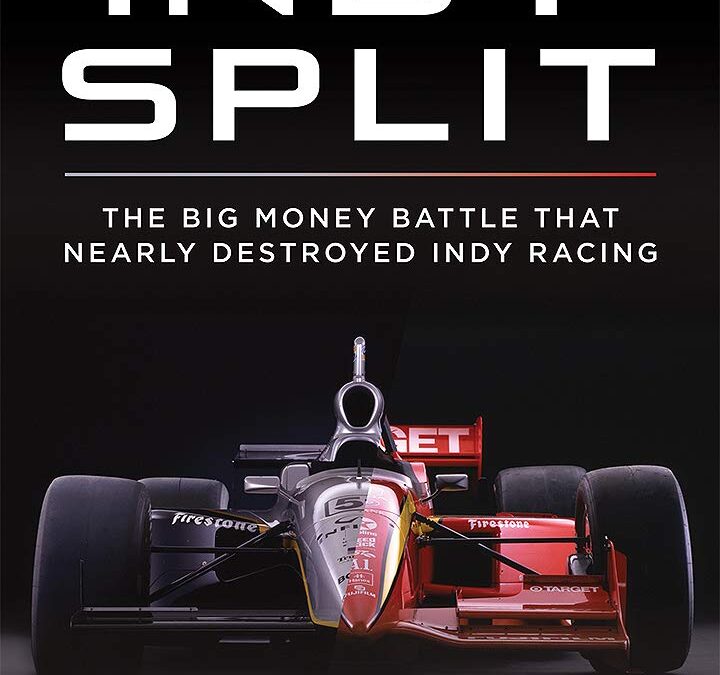
Indy Split is a fascinating, authoritative and overdue account of the big money battle that nearly destroyed the sport of Indy car racing.
In the new book, long-time motorsports reporter John Oreovicz dives deep into the divisive battle between CART and the Indy Racing League. With insightful reporting, Oreovicz recounts the political infighting within the industry which climaxed with a 12-year “Split” from 1996 to 2007 between competing forms of Indy car racing and prevented the sport from achieving its potential.
The book traces the roots of Indy car racing’s dysfunction, which began in 1945 when Tony Hulman rescued the Indianapolis Motor Speedway from potential redevelopment. Over the next 75 years, the Hulman-George family used the stature of the Speedway to carve out a powerful position in American auto racing that sometimes resulted in conflict with Indy car competitors. A volatile period in the late 1970s sparked the formation of Championship Auto Racing Teams (CART), and tensions ramped up even more when Hulman’s grandson, Tony George, assumed power in 1990.
In unprecedented detail, Indy Split uncovers how the Split forced Indy car fans, sponsors, broadcasters and participants to choose sides. The book brings to light the confusion and animosity which caused unnecessary damage to the sport, and covers how negotiations driven by legendary racer Mario Andretti and actor/racer Paul Newman ended the Split in 2008, only to have George to walk away less than three years later. The long struggle for stability was finally resolved in 2020 when Roger Penske acquired IMS and the IndyCar Series, securing a bright future for the Speedway, the Indy 500, and the sport.
Longtime motorsports reporter John Oreovicz began attending the Indianapolis 500 as a teenager in the late ‘70s, allowing him to witness the sport’s growth as an avid fan before documenting its decline as a journalist. With a foreword by Motorsport Hall of Fame inductee Robin Miller, arguably Indy car racing’s most vocal advocate, this is the real story of The Split from one of the sport’s most respected voices

Land Rover One Ten and Ninety Specification Guide is designed to give guidance on the original, ex-factory, specifications of the coil-sprung utility Land Rovers built between 1983 and 1990. Known to Land Rover as stage 2 models, they were sold as the Land Rover One Ten, Ninety and (later) One Two Seven.
James Taylor has taken the first step in undertaking detailed research into the Stage 2 models, and putting together all the known facts in one place. Topics covered include vehicle identification; specification changes in detail; options, accessories and special equipment; conversions and, finally, promotional material.
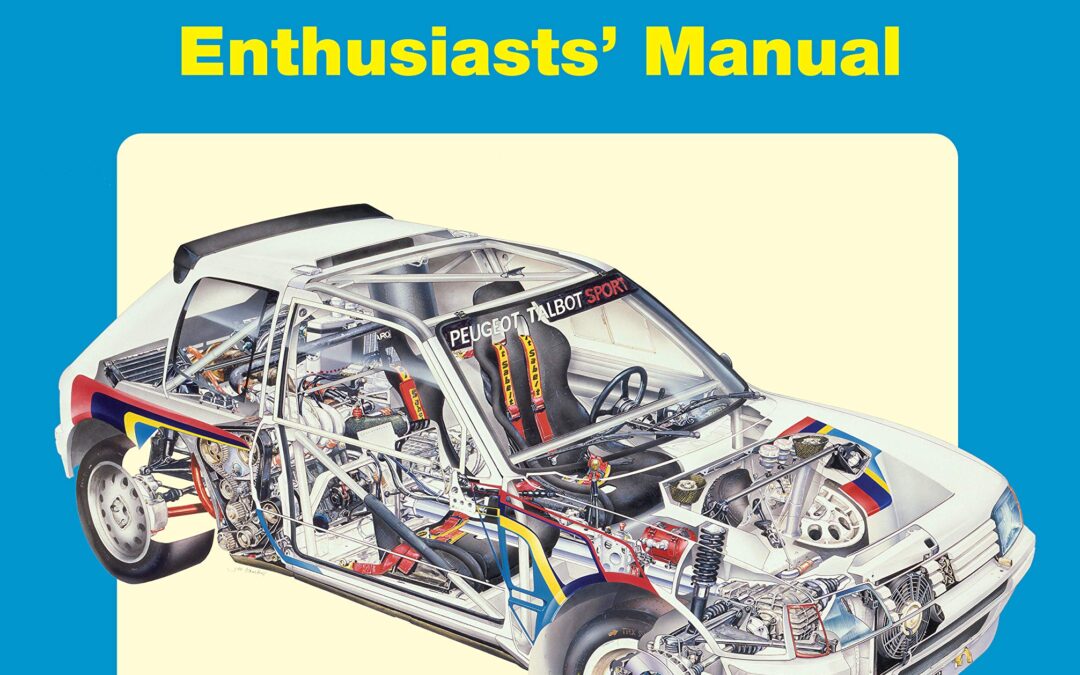
The Peugeot 205 T16 is the legendary Group B turbocharged four-wheel-drive rally car produced by Peugeot between 1984 and 1986. Between 1984 and 1986, 205 T16s won 16 World Championship rallies in the hands of Ari Vatanen, Timo Salonen, Juha Kankkunen and Bruno Saby, and lifted both the manufacturers’ and drivers’ titles in 1985 and 1986 in the hands of Timon Salonen and Juha Kankkunen, respectively, against strong opposition from Audi, Lancia, Ford and Austin-Rover.
The car was used to extraordinary effect by Peugeot as a marketing tool for the 205 road car, and the project lifted Peugeot to become a mainstream manufacturer to rival the established brands worldwide. The original 205 T16 appeared on the rally stages in 1984, while the revised ‘E2’ was introduced partway through 1985. The ‘E2’ incorporated various revisions raising power output to 550bhp.
After the cancellation of Group B at the end of 1986, Peugeot modified three 205 T16 cars to compete in the famous Pikes Peak Hillclimb, and later cars were modified to compete in the Paris-Dakar rally, winning in 1987 and 1988. The car also formed the basis of the ‘405 T16’, which won the Paris-Daker for Peugeot in 1989 and 1990.
Today, the appearance of 205 T16s is always eagerly anticipated at historic rally events, and motorsport retrospectives such as the Goodwood Festival of Speed.
Peugeot 205 T16 Group B Rally Car Enthusiast’s Manual chronicles the design, anatomy and operation of the 205 T16, with input from many of the drivers and engineers involved.

The word ‘Quattro’, chosen by Audi for its pioneering high-performance four-wheel-drive cars, immediately captures glamour and excitement in the minds of all motorsport enthusiasts. This book, written by a leading journalist and Quattro devotee, explores 24 years of factory-prepared and factory-supported Quattros in motorsport, from 1980 to 2004. It is a tale that extends from rough rally stages to race tracks, from pine-fringed ice trails in the depths of European winters to the shimmering heat haze and melting asphalt of Texas street racing. Along the way, it explains how Quattros collected four world rally championships, five American driver/manufacturer crowns and a single-year haul of seven international touring car titles, plus numerous other honours.
With the five-cylinder turbocharged Quattro in its original form, rallying in the early years yielded numerous wins, most of all in 1982, when seven victories in 11 world championship rallies brought the first title. With the short-wheelbase Sport added to Audi’s armoury, 1984 became an all-action, all-conquering rallying season with two more world titles won, for drivers (Stig Blomqvist) and manufacturers. Three stunning Pike’s Peak wins were achieved in America in successive years, for Michele Mouton (1985), Bobby Unser (1986) and Walter Röhrl (1987). Starting with double championships for the 200 quattro in TransAm (1988) and the 90 Quattro in IMSA (1989), racing success unfolded in America. Exuberant Hans Stuck was the star driver, but consistent team-mate Hurley Haywood captured that 1988 title. Touring car campaigns during the 1990s brought huge success, starting with fearsome V8 Quattro ‘racing limos’ in Germany. Global achievements followed with A4 Quattros in many national Super Touring series throughout Europe and in Australia, including Frank Biela’s 1996 title-winning campaign in Britain. Audi continued to win on track in the new millennium as race versions of the S4 and RS6 captured five SCCA GT Championship titles in America.

Spend a tumultuous week behind the scenes with Kenny Wallace and the Square D team as their independently funded team fights to compete with the best of the best in the 1990s, the golden era of NASCAR racing. This rambunctious tour takes you into the driver’s seat, the cocktail parties, the race shop, the broadcast booth, and beyond, providing a look at the sport during the height of NASCAR popularity. As Jeff Gordon, Dale Earnhardt, Dale Jarrett and other legends fight for the championship, Kenny Wallace and the Square D team’s battles to qualify and stay relevant in an era when a spot in Sunday’s show was hotly contested and not guaranteed. Author Scott Huler spent months with the team so he could chronicle how stock car racing works through the window of the 1997 races at Martinsville and Charlotte Motor Speedway. The result is a dramatic read that offers insight on the inner workings of NASCAR team, from tire and gas strategy to engineering, car set up, and the fine points of a fabulous pit stop. Throughout the book, the author captures Wallace’s fiery discourse and passionate personality, and takes the reader into all corners of NASCAR racing, from tech inspections and RVs in the infield to cocktail parties and banging fenders on the track. In A Little Bit Sideways, author Scott Huler goes over the wall and does for NASCAR what Roger Angell did for baseball, David Foster Wallace did for tennis, and Hunter S. Thompson did for the Kentucky Derby—capture the soul of the sport with gritty, honest reporting of its colorful characters and distinctive landscapes.
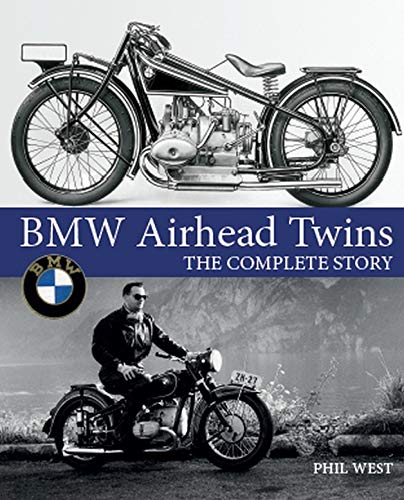
No motorcycle manufacturer is more closely associated with one type of engine than BMW: the air-cooled boxer twin or ‘airhead’. It was included in BMW’s very first motorcycle in 1923 and virtually every machine the company made, of every type, from radical road bike to TT winner, to land speed record holder, to 1970s style icon and even to the creation of an all-new adventure bike class with the R 80 G/S, right up to the mid-1990s.
BMW Airhead Twins, with over 290 photographs, includes a history of the company pre- and post-War, and the personalities behind the development of the bikes. Profiles of each of the ‘R’ bikes in turn includie detailed specification guides and production numbers. An epilogue that looks to the future of the airhead twins completes the book.
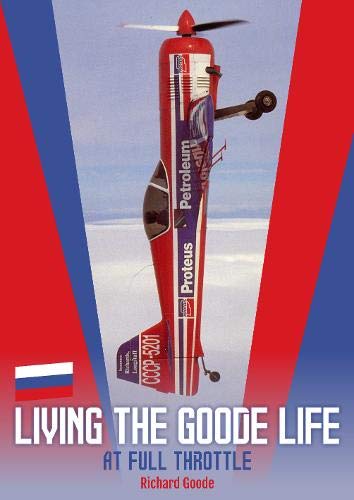
This is an extraordinary story, beginning with a bare-foot colonial childhood, and indeed not speaking English until he was four, yet ending up at Cambridge, ultimately dealing at the highest levels of the Russian aviation industry. Richard Goode’s life has been a fascinating series of activities, both social and business, dealing with an incredible range of people from the notorious Ugandan dictator, Idi Amin, to whom he was selling banknotes (legally) to a car dealer who was embroiled in the Brinks-Mat gold robbery (illegally); dealing with Russian spies at the behest of MI5; international corporate headhunting and aerobatics at the highest levels. And all this with a huge zest for living life to the full.
Highlights of his life have included:
- as a teenager, hitchhiking from London to Cape Town
- becoming one of the world’s top aerobatic pilots and making his own very successful aerobatic aircraft
- buying the first privately owned Russian aeroplane in the West and then acting as a sales agent for Sukhoi
- selling over 450 aircraft and the world’s only privately-owned Harrier jet fighter
- establishing a barely-credible business sending people from the West to fly front-line Russian jet fighters
- Totally restoring three significant English listed country houses and a run-down tea estate in Sri Lanka
- Owning a wide variety of cars from old bangers to Jaguar XKs, vintage Rolls-Royces to modern Ferraris
Throughout, his life been anything but straightforward, with a fair share of crashes and calamities. Financially, he narrowly avoided meltdown in the ruinous Lloyds insurance crash of the 1990s; he successfully faced up to the Russian Mafia and was even served with an Interpol arrest warrant! Most dramatic was the structural failure of his aerobatic plane during a public display resulting in a barely-survivable, catastrophic accident, leading to three months in a hospital bed.
We live in a very sanitised and protected world and it is refreshing to read this story about a man who has been prepared to take risks and also to accept the consequences of them, whether positive or negative. A thrilling, real-life tale.
This book is complemented by a rich selection of appealing and fascinating images.
- Jacketed Hardback, 376 page extent, 240 mm x 170 mm in portrait format
- Over 150 colour & b/w photos








